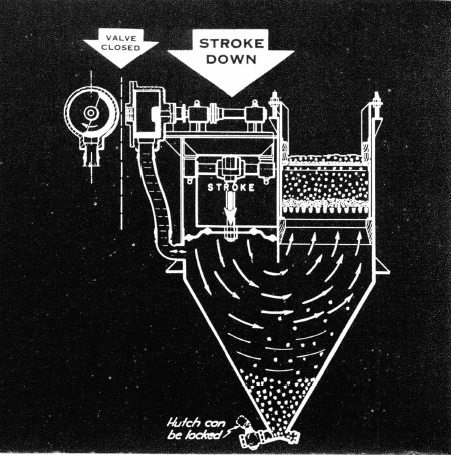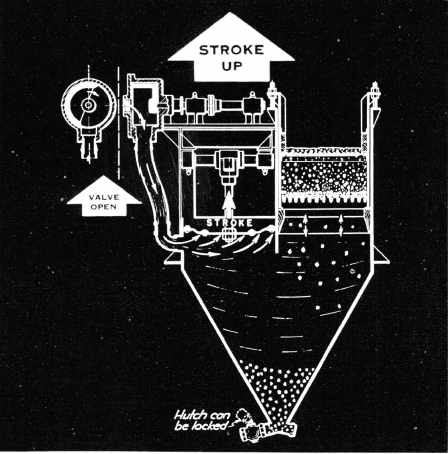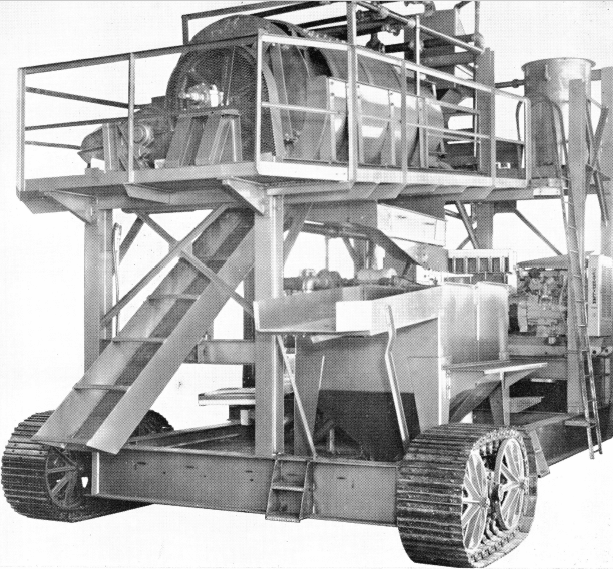The handling of large quantities of gold-bearing gravels is of utmost importance for most successful placer operations. In addition to providing efficient washing and recovery methods, the placer plant should be constructed as a compact unit that can be readily moved. This is an important consideration because the washing and recovery plant should be close to the mining area at all times to minimize the distance that the gravels must be transported. A second consideration is the necessity of providing a means for discarding the tailings.
The Flowsheet
The above flowsheet was developed to meet the foregoing requirements and has a capacity of approximately 50 cubic yards of bank-run gravel per hour.
FEEDING: The method of mining or excavating will depend on the local conditions such as thickness of gold-bearing gravels, amount of overburden, quantities of large boulders, water table, topography, etc. In this study, however, the deposit is mined using a dragline which dumps directly into the feed hopper. Large boulders are rejected by a heavy 8″ grizzly located on top of the feed hopper. The gravels are transported to the washing and concentrating plant by means of a belt conveyor. The feed hopper and conveyor are of portable design for moving as the mining progresses.
Washing and Concentrating Plant: This is a compact unit (about 15′ x 30′) utilizing the washing and concentrating equipment shown on the flowsheet. It is designed to mount on a structural steel frame equipped with crawler type forged tracks for moving from one location to another. This unit could also be adapted to a pontoon-type floating boat.
As the gravels are discharged to the feed box, water is added and the gravels flow over primary riffles to the washing and scrubbing trommel screen. The primary riffles act essentially as a nugget trap to prevent loss of occasional pieces of gold that might be larger than the ¼-inch opening on the trommel screen. The scrubbing section of the trommel screen provides intense washing of the gravels to disintegrate all clay prior to screening and rejection of the oversize gravels. The trommel oversize discharges to a portable conveyor which can be pivoted in a 90° arc. This gives maximum disposal in any given location. The ¼-inch undersize from the trommel screen passes over the secondary riffles and then to a 24″ x 36″ Duplex Mineral Jig. The tailing from the jig passes through a tertiary sluice box and then to waste. This product is usually impounded to prevent stream polution.
The riffles used in the three stages of sluice boxes are of the Hungarian type. The sluices are lined with cocoa matting.
The Mineral Jig concentrates are discharged to a 12″ Dewatering Screw Classifier and then fed to the number 12-S Wilfley Concentrating Table for cleaning. The quantity of jig concentrate is reduced by the table and is ideal for charging to the Amalgam Barrel. If any valuable minerals are contained in the black sand, the table can be used to produce a separate black sand concentrate for direct marketing or further beneficiation. The water overflowing the dewatering classifier together with the water and rejected sands from the cleaning table all flow into a 2″ Vertical Sand Pump. This product can be discarded as waste, or recirculated to the initial feed box preceding the trommel and used for wash water. If this procedure is used, the black sands should be removed by the table so as to not be recirculated and ultimately build up to an excessive extent in the concentration units.
The table and amalgam barrel can be utilized in cleaning the concentrates from the riffles, but the coarse gangue should be removed by screening prior to tabling.
A separate water pump is required for furnishing the water to the plant. A head tank is also necessary for delivering a constant flow of water to the jig and table.
The power for this portable unit consists of a 60 KW diesel generator set which is an integral part of the unit.
The Amalgam Barrel is not included on the plant since it is usually desirable to conduct the final clean-up at a separate site.

Secret of successful operation and high gold recovery is the Selective Mineral Jig. This unit handles an unclassified feed and it is not necessary to have a closely sized feed in order to achieve high tonnage and maximum recovery.

A rotating water valve automatically compensates for the action of the pulsating diaphragm plunger. This provides controlled quiescent periods for true hindered settling of the heavy particles. As the bed opens up gravity permits heavy minerals to enter the hutch.
PORTABLE PLACER UNIT INCORPORATES TECHNICAL ADVANCES IN GOLD RECOVERY
The new 50 cubic yard per hour Portable Placer Unit is complete and compact. Latest technical advances in gold recovery make it capable of both high tonnage and efficient recoveries. Everything is supplied including feed hopper, water tank, piping, valves, electrical switchboard, diesel power unit and the gold recovery equipment. A general discussion on placer operations is on pages 15-16 of this issue.
Complete details on the Portable Placer Unit for all tonnages are in Bulletin No. P1-B22. Smaller Trommel Jig Placer Units are described in Bulletin P1-B20 and the Mechanical Gold Pan, in Bulletin P1-B17.

